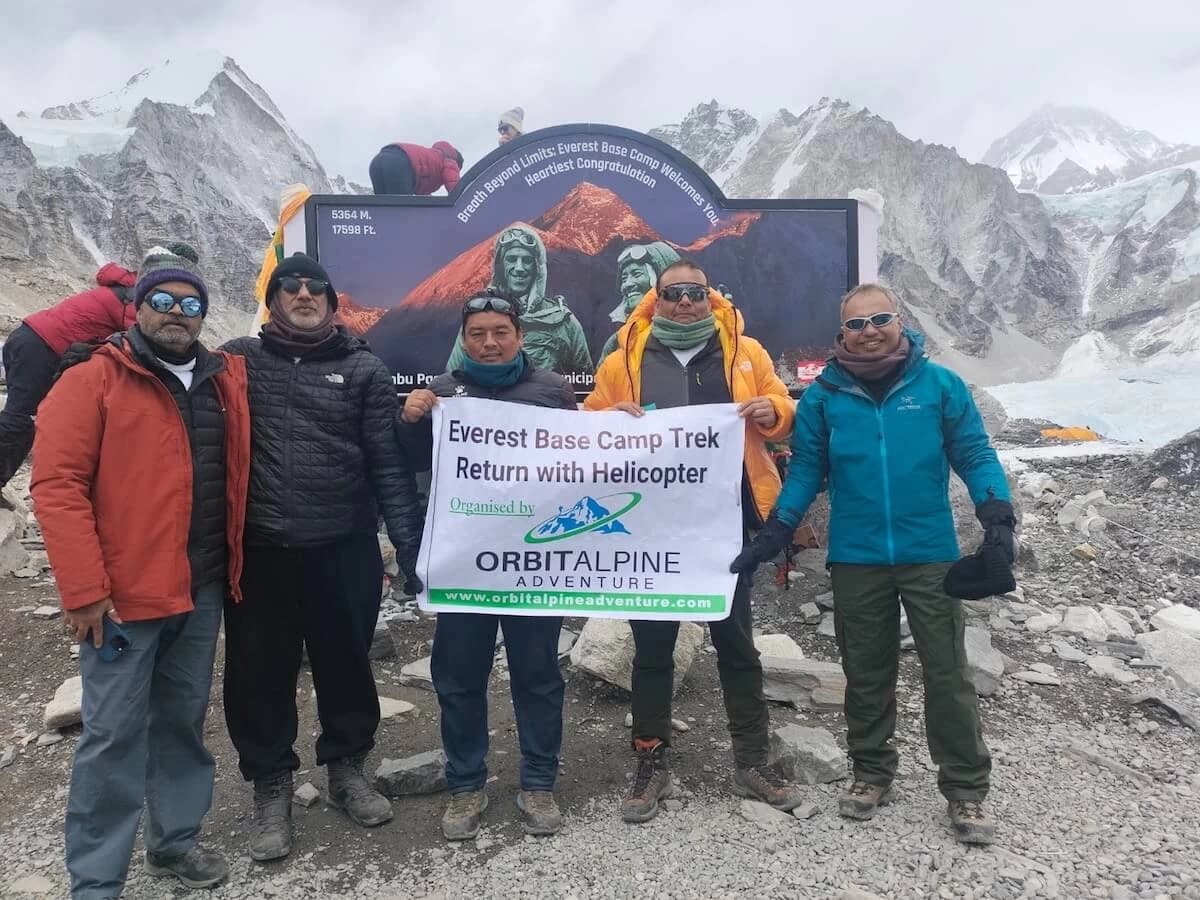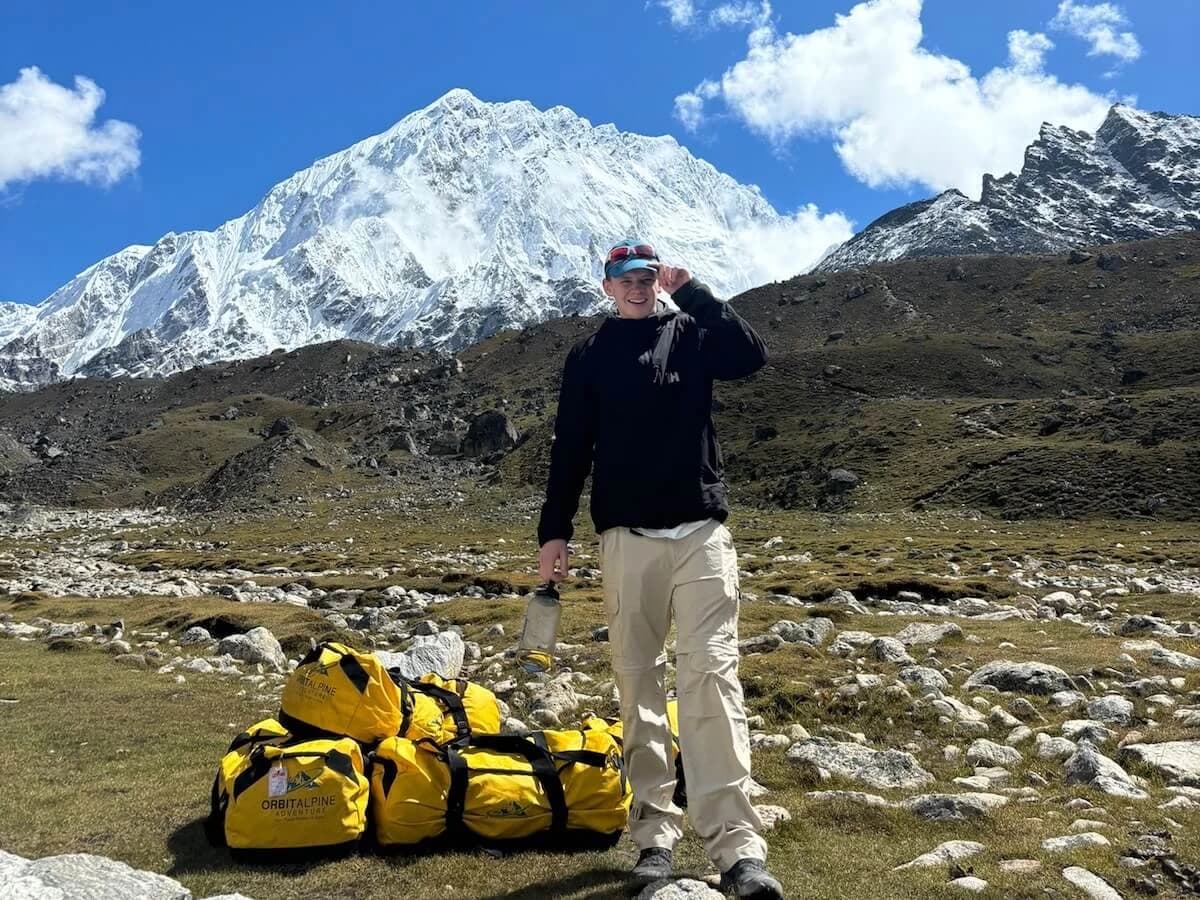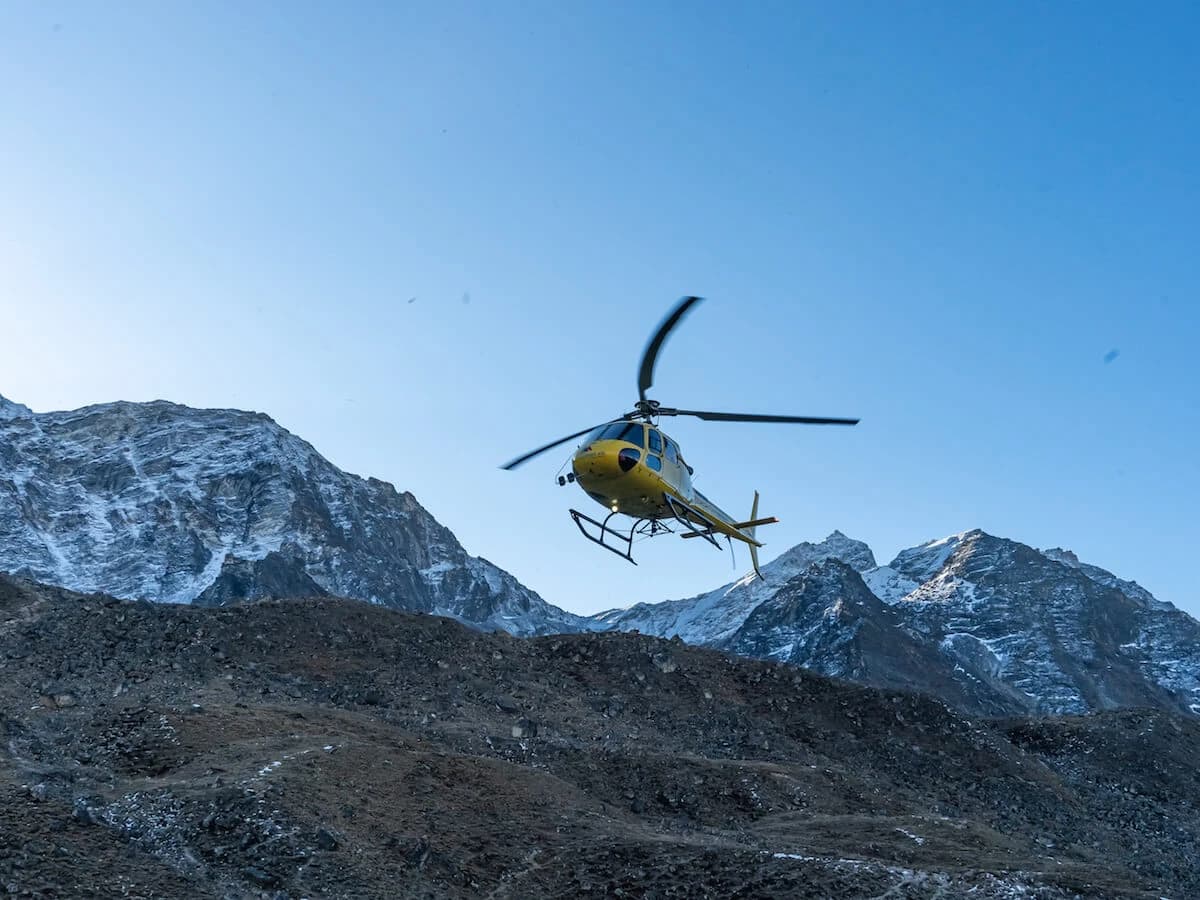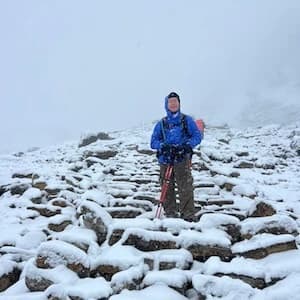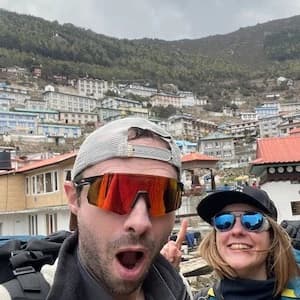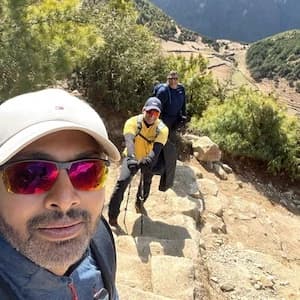Everest Base Camp Trek with Helicopter Return is a magical journey that combines breathtaking Himalayan views, rich Sherpa culture, and the thrill of adventure—all in a shorter time. Starting with a scenic flight to Lukla, then the trek takes you through charming villages, ancient monasteries, and rhododendron forests, leading up to the iconic Everest Base Camp. The unforgettable sunrise from Kala Patthar and the thrilling helicopter ride back to Kathmandu make this a dream trek, perfect for those short on time but full of spirit.
Everest Base Camp Trek Return by Helicopter
Highlights
- Scenic flight from Kathmandu to Lukla
- Sherpa cultural villages like Phakding, Dingboche, Pangboche, Lobuche, etc.
- The main trade center if the region, Namche Bazaar
- Hike to Everest View Hotel, the highest altitude hotel in the world
- Sherpa Museum, ‘Hall of Fame’ for the photos of ‘Sherpas and Tenzing Hillary’ during their expeditions
- The largest and oldest monastery of the Khumbu region, Tenboche Monastery
- Well-defined trail passing through dense rhododendron and pine forests
- Sagarmatha National Park, the highest mountain conservation area in the world
- Reaching the base camp of the world’s highest peak
- 360-degree panoramic view of the Himalayan Giants of the Everest region from Kala Patthar
- The helicopter flight from Gorak Shep showing the 100 percent of the Khumbu region
The Everest Base Camp Trek Return by Helicopter package is a flawless option for tourists with limited vacation time who still want to experience the spectacular beauty of the Great Himalayas in Nepal. Despite its conciseness, this trek offers a remarkable sight of the regal peaks of the Khumbu region, with three of the world's uppermost mountains: Mt. Everest, Mt. Lhotse, and Mt. Cho Oyu.
Nearby these high giants are plentiful other snow-capped peaks, creating a spectacular view that will stay with you long after you return home. In spirit, it's a compact yet amazingly gratifying adventure that summarizes the overwhelming magnificence of the Himalayas.
The Everest Base Camp trek with helicopter return option stands out as the foremost choice for adventure-chasers in Nepal, offering a perfect and efficient journey from Kathmandu to Everest Base Camp and back. Trekkers are drawn to this option not only for its time-saving satisfaction but also for the exceptional aerial views it provides of Mount Everest and the nearby Himalayan peaks.
This exclusive perspective, similar to bird's-eye viewing, adds an extra layer of excitement and attraction to the experience. Besides, for people with limited time or knee problems that make downhill trekking demanding, the helicopter return option offers a comfortable and ease solution. In spirit, it's the ultimate combination of convenience, overall views, and convenience making it the top choice for those looking for a cherished Everest adventure.
Trekking in Nepal is understood to Everest Base Camp requires physical fitness, strength, and mental promise, along with important permits like the TIMS card and Sagarmatha National Park Entry Permit. Through the journey, you'll dip yourself in the rich Sherpa culture, observing their ancient Tibetan Buddhist traditions that have endured for centuries.
Along the way, you'll genius at the overwhelming Himalayan peaks, visit ancient monasteries, and encounter the extraordinary biodiversity of the high-altitude national park. The trek also treats you to luxurious valleys, varied sceneries, and remarkable glaciers and icefalls, making it a truly memorable adventure in the core of the Himalayas.
Your trip through the Nepalese Himalayas begins with a scenic flight from Kathmandu to Lukla, helping as the gateway to the famous Khumbu region trekking. From there, you progressively go towards Namche Bazaar, the active profitable hub of the Sherpa region, where you'll take a day for adjustment.
During this interruption in Namche Bazaar, you'll have the chance to visit the famous Everest View Hotel, one of the world's highest-altitude locations and offering pleasing views of the nearby Everest peaks. Moreover, you'll explore the cultural, historical, and creative wonders of Tengboche Monastery, the major and oldest monastery in the area.
During October or November, Tengboche Monastery organizes the big celebration and puja festival known as Mani Rimdu. This auspicious occasion offers a delightful immersion into Tibetan and Sherpa cultures, providing visitors with an authentic and complementary experience. Among the awesome Himalayan backdrop, visitors can partake in the festivities, watching traditional dances, rituals, and ceremonies done by monks ornament in lively attire.
The atmosphere is filled with worship and joy as locals and tourists come together to celebrate, offering a rare chance to delve deep into the rich cultural textile of the region. In core, attending Mani Rimdu at Tengboche Monastery promises a memorable glimpse into the heart and soul of Himalayan heritage
Through your stay in Dingboche, another adjustment day permits you to sightsee Nagerjun Hill (5,100m) via a steep yet appealing trail. From this vantage point, you'll be treated to wonderful views of Lobuche East & West, Tobuche, Thamserku, Kangtega, and Ama Dablam, offering a welcome commotion from the severities of the trek.
Enduring onwards from Lobuche, you'll rise to Gorak Shep and board on an unforgettable hike to Everest Base Camp, trailed by a sunrise trek to Kala Patthar the next morning. After soaking in the spectacular 360-degree all-around views of Mt. Everest and its near peaks, you'll settle your adventure with a picturesque helicopter flight back to Kathmandu, confirming a summary and outstanding return trip.
The Langtang Valley hike naturally takes around 10 to 12 days to complete, making it an appropriate alternative to the 14-day Everest Base Camp trek. It offers spectacular views of the Langtang mountain range, with Langtang Lirung, Ganesh Himal, and other mountains. Like the Everest Base Camp trek, the Langtang Valley trek offers plenty of time for adaptation with rest days involved in the itinerary. You'll progressively climb to higher altitudes, walking about 10 to 15 kilometers per day within 6 to 7 hours of walking.
The Langtang Valley trek is also mainly a teahouse trek, meaning you'll have way in to relaxed lodging and meals along the way without the need to carry camping equipment or hire many porters. This helps keep costs down and allows you to dip yourself in the local culture as you network with the teahouse owners and other explorers.
Orbit Alpine Adventure can help you in forming the Langtang Valley trek, confirming that your experience is safe, enjoyable, and outstanding. Orbit Alpine Adventure is ready to meet its slogan “Clients’ Satisfaction is Our Motto!”
Best Time for Everest Base Camp Trek with Helicopter Return
The prime times for the Everest Base Camp trek with a helicopter return are during the spring (March to May) and the autumn (September to November). These periods offer the best climate conditions, with steady weather, clear skies, and mild temperatures. The paths are in admirable condition, and visibility for mountain views is at its highest, confirming a safe and spectacular trekking involvement.
Autumn | late-September-November
Autumn and spring indeed offer phenomenal weather conditions for wandering in Nepal, each with its own exclusive charms. During autumn, which comes after the monsoon season, the scenery is relaxed by the rain, offering clear and spectacular views of the Mahalangur Himalayas. The air is crunchy, and the skies are often crystal clear, providing outstanding prominence for trekking and tourism.
On the other hand, spring brings its own attraction with clear blue skies, warm days, and sufficient sunlight. The weather is normally enjoyable, making it a perfect time for outside activities and adventures. The temperature in the higher hills naturally ranges from 15°C to 24°C during this season, offering relaxed conditions for search.
The change from the monsoon season to autumn in Nepal can bring some enduring rainfall in the first few weeks of September, sometimes covering into late September. Though, by late September, autumn takes full grip of the region, offering peaceful and clear environments that last until late November.
For those scheduling an Everest Base Camp helicopter return trek, aiming for this precise time frame—from late September to late November—safeguards a higher probability of success due to the auspicious weather conditions. It's vital to note that during this peak season, the trails will be busy with many other trekkers, adding to the lively atmosphere of the trip.
Spring | March-May
Spring, known as the time of flowers, boons another wonderful chance to embark on an Everest Base Camp trek with a helicopter return. This time of year, offers steady temperatures and climate circumstances in the Himalayas, provided that trekkers with dependably beautiful trekking situations.
Through the spring season, explorers can enjoy the spectacular sceneries decorated with exciting flowers, adding to the already wonderful background of the region. The temperatures in the upper hill areas normally range from around 16°C to 23°C during this season, making relaxed conditions for trekking and sightseeing.
During the spring season, the acceptable temperatures are supplemented by clear skies, lush green sceneries, and royal, see-through mountain views. It's a time when the attractiveness of the Himalayas is at its highest, drawing explorers from all corners of the world to the paths.
Still, it's vital to note that spring is also a demanding period on the walking trails. The promising weather conditions attract hundreds of people looking to experience the glory of the Everest region firsthand. Despite the crowds, the attraction of the unspoiled sceneries and the aptitude of clear views make spring a highly desirable time for trekking in Nepal.
For those scheduling an Everest Base Camp helicopter return trek, April stands out as the perfect month to board on the trip. By April, the temperatures have warmed up, submitting more relaxed conditions for walking. Moreover, the climate inclines to be steadier in April, with clearer skies and reduced chances of rainfall, making it a prime time for relishing the fabulous views along the walking route.
So, while spring as a whole is a brilliant time for walking in the Everest region, choosing April for your trip confirms the best weather conditions and a more pleasurable overall experience.
Summer| June-August
Summer in Nepal, from June to August, is considered as high temperatures, humidity, and recurrent rainfall. The mountains are often hidden by clouds during this time, but after rainfall, they disclose themselves in magnificent clarity, offering an energizing and gratifying sight for trekkers.
Trekking paths in Nepal during summer are less packed, but they present many tests. Cloudburst makes routes slippery and muddy, increasing the risk of landslides. Leeches and mosquitoes are plentiful, adding to the trouble. In spite of these hindrances, trekking in summer offers an opportunity to experience the serenity of the trails within luxurious greenery and re-energized sceneries.
During summer, scheduling an Everest Base Camp Trek return by helicopter may not be practicable due to uneven climate conditions. Operating helicopters in demanding weather stances significant risks and doubts. If late August is your only accessible time, it's a better choice due to lower rainfall levels to the end of summer.
Winter| December-February
Winter in Nepal, from December to February, brings cold temperatures, the coldest time of the year. Due to the thrilling cold, there's a reduction in the number of explorers visiting Nepal throughout this season.
During winter, day temperatures in Nepal hover around 9°C to 12°C, falling lower at night. Higher elevations, like Everest Base Camp, experience sub-freezing temperatures. In spite of the cold, many explorers courageous the challenges of winter trekking, accepting the privacy and exclusive beauty of the snow-covered sceneries, making it a gratifying though more severe experience.
Low-altitude hikes or short tours in Nepal during winter are usually unaffected by snowfall. However, higher elevation regions may experience heavy snowfall, adding more demands to the journey. Wandering in Nepal during winter offers the perquisite of spectacular snow-covered views, exclusively in higher areas. The mountains seem freshly decorated, creating an energizing and attractive scenery during this time of the year.
The Nepalese Himalayas are undergoing deep-seated climate alteration due to global warming, which intensely affects both human activities and natural phenomena. The fast melting of glaciers, changes in the structure of glacier lakes, and rare snowfall and snowstorms are instigating widespread tragedies. These changes pose important contests to societies needful on the mountains for their livings, such as agriculture and tourism.
Furthermore, the enlarged occurrence of natural disasters like floods, landslides, etc. threatens lives and infrastructure. Addressing these challenges needs vital action to ease climate change effects and implement adaptive procedures to protect vulnerable populations and ecosystems in the Himalayas.
Due to the effect of global warming, there's an obvious shift in weather forms in the Everest region. Even during habitually colder months like December and January, the climate remains clear without snowfall. Likewise, during the monsoon season from June to mid-September, there's a lessening in rainfall.
These changes are making it possible to start the Everest Base Camp trek with a return helicopter at any time of the year. This shift in climate patterns permits greater flexibility in arrangement treks, offering enthusiasts the chance to board on this adventure during off-peak seasons traditionally well-thought-out and less promising.
Join a helicopter flight from different points on the Everest base camp trail
We offer helicopter pickups and drop-offs at numerous points along the Everest Base Camp trail, like Lukla, Namche Bazaar, Tengboche, Dingboche, Pheriche, and Kala Patthar. Just reach out to us with your necessities, and we'll organize the best helicopter crew on time. Choose among group joining or chartering a private helicopter for your ease.
Food and Accommodation during the Everest Base Camp trek helicopter return
During the Everest Base Camp trek with helicopter return, finding food and restaurants is not a matter, as there are plentiful tea houses and lodges along the way. These institutions, run by locals, offer a variety of cuisines including Chinese, Indian, Continental, and Nepalese. They provide to the various tastes of visitors, safeguarding a nourishing dining experience through the journey.
Common food items include noodle soup, Mo: Mo, pizza, and noodles. Traditional Dal Bhat is preferred, and also available in most tea houses. Beverages like tea, coffee, and energy drinks are also assisted. Bakeries are accessible at many trek stops. Drinkable water is available at teahouses and water taps along the trail, using cleansing tablets to confirm safety before drinking.
Teahouses and lodges offer rooms along the journey, offering food, drinks, and twin-sharing rooms. These rooms classically consist of two beds, a table, and all essential bedclothes for a relaxed night's rest. Rooms in teahouses do not have attached bathrooms; common toilets are accessible. While clean and practically priced, teahouses offer elementary accommodations without extravagance. Additional facilities like hot showers, Wi-Fi, and electronic charging may be accessible for additional charges..
Difficulty Level of Everest Base Camp Helicopter Return
The Everest Base Camp trek with helicopter return is demanding despite the ease. Continuing various hurdles is unavoidable on this journey, making it a tough but gratifying adventure.
Trekking Distance and Hours
As the trek starts from Lukla and ends up at Everest Base Camp, you will cover a total distance of around 65 Kms. To cover the distance on time, you will have to walk for about 5 to 8 hours daily. The trail is not as easy as you think. It is full of regular rough ups and downs.
The trek from Lukla to Everest Base Camp is about 65 kilometers, needing daily walks of 5 to 8 hours. The path presents continuous ups and downs, exciting trekkers with its rocky land and demanding scenery. Beginner trekkers may find covering such distances tough in a single day on rocky land. Former trekking experience helps to go through the trekking hours. Less experienced individuals are more likely to find difficulties on the path.
Altitude Sickness
The Everest Base Camp trek return by helicopter involves important elevation gain, concluding at Kala Patthar (5,644m). Beginning from Lukla at 2,860m, explorers progressively ascend, experiencing increasing height through the journey. This raise gain presents a challenge, requiring proper adaptation and homework for altitude-related matters.
Altitude sickness stances a serious risk for explorers on high-altitude journeys like the Everest Base Camp trek. Those affected may undergo challenging symptoms, necessitating instant treatment and possibly emergency withdrawal. Proper adjustment and awareness of altitude-related issues are vital for lessening the risk of illness.
Novel Weather
The climate in the Everest region presents exclusive challenges for explorers, especially those unusual to Himalayan conditions. The crisp and chilly temperatures, along with changeable weather patterns, can pose problems for those from lower altitudes. Flexibility and an open-minded approach are important for managing the ever-changing weather conditions come across during the trek, helping to minimize possible challenges along the trip.
Difficult Trail
As the height increases, the Everest Base Camp trek becomes gradually difficult and exciting, with steep and rough paths to cross. Sufficient homework is important for overpowering the obstacles bumping along the way. Novices on the Everest Base Camp trek may face moments of willingness to give up. Suitable training and preparation are important to build comfort and flexibility to embark upon the challenges of the path.
How to get yourself ready for Everest Base Camp Trek?
The Everest Base Camp trek with helicopter return involves at least 65 km long walks over several days. You have to trek for anywhere around 5 to 8 hours daily. It may sound easy to experienced trekkers, but not for novice ones. It can turn into a problematic piece of cake for those who are not so good at physical fitness.
Cardiovascular Training
Cardiovascular training is all about increasing the oxygen levels in your body. In a trek like Everest Base Camp, your body’s oxygen plays a vital role. If you have a fit cardio level, your body can produce more oxygen, which helps in fighting altitude sickness. Therefore, you should do cardiovascular training such as swimming, running, jogging, hiking, stair climbing, and uphill hiking.
Doing that will allow you to have an excellent cardiovascular system. Start this training at least 5 to 6 months before the trek date and be consistent. The more often you engage in these activities, the more prepared you will become for the trek.
Strength Training
The Everest Base Camp Trek demands high strength from every trekker. If you feel you lack muscular strength, then incorporate strength training into your regimen. In this program, the main focus is on strengthening various parts your body, such as, muscles, shoulders, back, and abdomen. In summary, it is about fortifying your body to tackle challenges during the trek.
You have to keep walking on rugged trails while carrying a heavy backpack on your back. Therefore, you should consider building up your strength level. For this, you can hit the gym regularly at least 5 to 6 months before the date. Go to the gym and do sit-ups, pull-ups, crunches, or whatever it takes to make your body enduring.
Mental Training
Mental training is equally important if you are daring to trek Everest Base Camp trek. This trek has its fair share of hurdles that require a mentally fit mind to keep going. A mentally unprepared trekker may consider giving up quite quickly during the trek.
That is why you have to be aware of the difficulties of the excursions, such as rugged trekking trails, walking tours, and altitude factors. Additionally, you have to be open to the available services and facilities during the trek. That awareness will help you find ways to avoid or endure those challenges.
Altitude Training
Altitude training occurs naturally, if you do all of the above training correctly. Cardiovascular and strength training will make you fit enough for the trek, and so will mental training. You will encounter high altitudes only during the trek. What you can do during this time is follow the precautions. If you are keep your body hydrated and stroll, you will avoid mountain sickness.
Some Tips for a safe Everest Base Camp trek and return via helicopter
The Everest Base Camp Trek is a challenging adventure unless you follow helpful tips and are well prepared. We have presented some of the must-follow tips for your Everest Base Camp trek helicopter return. If you adhere to all the tips below, you will have a safe and memorable experience.
Many people wonder How safe is Everest Base Camp Trek With Helicopter Tour during their return. If you check the weather and with our experianced pilots, the flight is considered to be very safe.
- Plan the trek at the right time- Plan the trek at the right time to ensure safe journey. As you know, the correct times have the right weather conditions. You won't have to face any weather challenges at all. Trekking at the right time ensure a more effortless experience.
- Prepare Accordingly- You should engage in training such as cardio, strength, mental, and altitude training. Moreover, you have to start arranging all things for treks, such as visas, equipment, insurance, and gear. If you are up to all of the required preparation, you will not face any difficulties during the trek.
- Pack the Essentials Wisely- If you have packed your backpack for the trek wisely, you will thank yourself later on. Many trekkers do not take this seriously and pack everything they see. They also choose quality-less gear, and as a result, they have to face various problems. To avoid such challenges, you have to pack your backpack wisely. Put in the things that are useful and durable during the trek.
- Choose a licensed Agency- A licensed agency offers various perks when it comes to trekking in Nepal. Agencies like ours plan your trip thoroughly and safely. From the arrival to the departure of guests, we stay with you throughout. Everything becomes hassle-free and safe if you trek with us in Nepal.
- Hire a trekking guide or porter- You surely need someone to guide you in the right direction and someone to carry your heavy backpack. By doing so, you explore the beauty and experience of the trek freely. The guide and porter will take care of all the other things for you. If you choose to make this trip with us, we will assign experienced porter and guide for your comfort.
- Take Altitude Sickness Seriously- You cannot take altitude sickness lightly. Every trekker on the trail to Everest Base Camp can be exposed to this sickness. If you get caught by it, you may have to face any sort of circumstances. Thus, you need to follow the precautions like trekking slowly, drinking enough water, and avoiding smoking and drinking alcohol. If you follow all of them, then you can remain on the safe side.
Note:- For a private Everest base camp trek and return by helicopter, please contact us at 9851144521 WhatsApp, Viber and Telegram. We are available 24 hours a day, 7 days in a week.
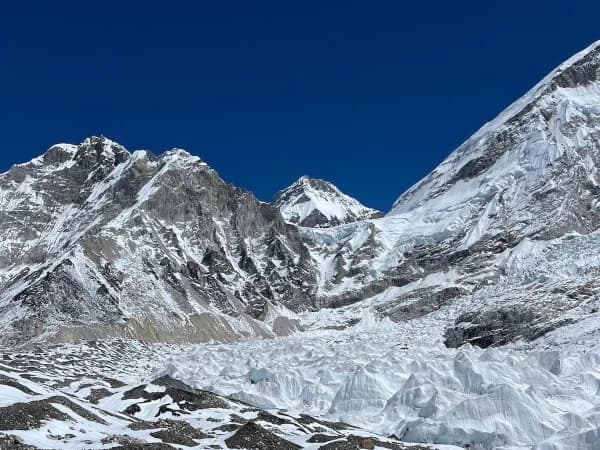
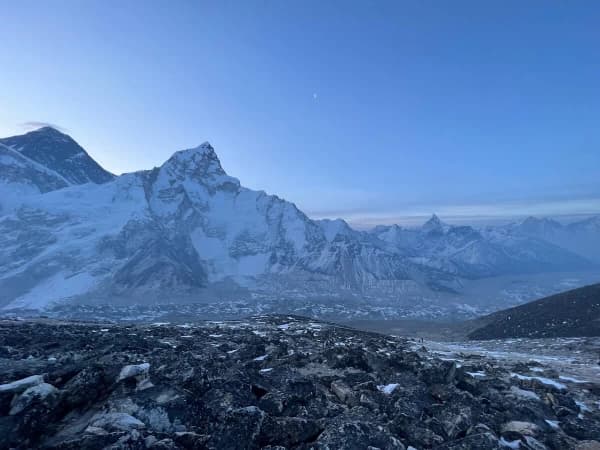
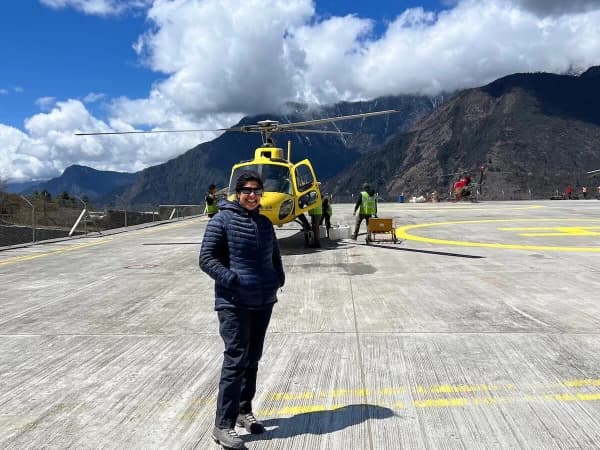
- All ground transportation includes pick-up and drop-off from airport to hotel and vice versa in a private vehicle and other required transportation.
-
2 Night three-star level hotels with breakfast is included in Kathmandu on your arrival day in Nepal and last day from the Everest Base camp trek with returning by helicopter day.
- Farewell dinner
- All accommodation during the trek which covers standard hotel as far as available (lodge, breakfast, lunch dinner)
- Government license holder English speaking Trekking Guide (5 or above trekkers: 1 extra assistant guide will be provided) and porter to carry trekkers luggage (2 trekkers: 1 porter)
- Trekking guide, porters, and their accommodation which covers lodging, meals, insurance, salary, transportation, two-way domestic flight tickets, and other necessary equipment required.
- Water purification tablets during the trek
- Sagarmatha National Park entry permit fee.
- Khumbu Pasang Lhamu Rural Municipality fees.
- Trekking map and Trekking
- First aid medical kit and Oximeter to check pulse for blood oxygen saturation during the trek; this will help recognize early signs of altitude sickness while being in the high altitude. This will be done by our trained staff.
- Duffle bag for the trek
- Sleeping bag and Jacket can be arranged upon request (you are recommended to bring your own )
- Will assist in arranging rescue and evacuation arrangement in the worst case during trek due to weather condition, natural disaster, etc
- All government taxes and office service charge
- International Flight Tickets to and from Nepal
- Nepal Entry Visa Fees which can be obtained upon arrival at the Tribhuwan International Airport in Kathmandu ( Multiple entry tourist visa for 30 days can be obtained by paying USD 40 and 90 days multiple entry visa by paying USD 100 or equivalent in foreign currency ( please make sure to bring 2 passport size photo)
- Hot shower, WiFi, phone call, charging electronic equipment during the trek only (unless it is free)
- Extra night accommodation during the trek (in case the itinerary becomes longer due to unpredictable circumstances)
- Personal expenses (shopping, snacks, bottled water, hot water, cold drinks, souvenir, etc)
- Travel insurance should also include high altitude rescue and evacuation
- Tips and gratitude to your guide and porter
- All the cost and expenses which are not mentioned in the ‘Included’ section
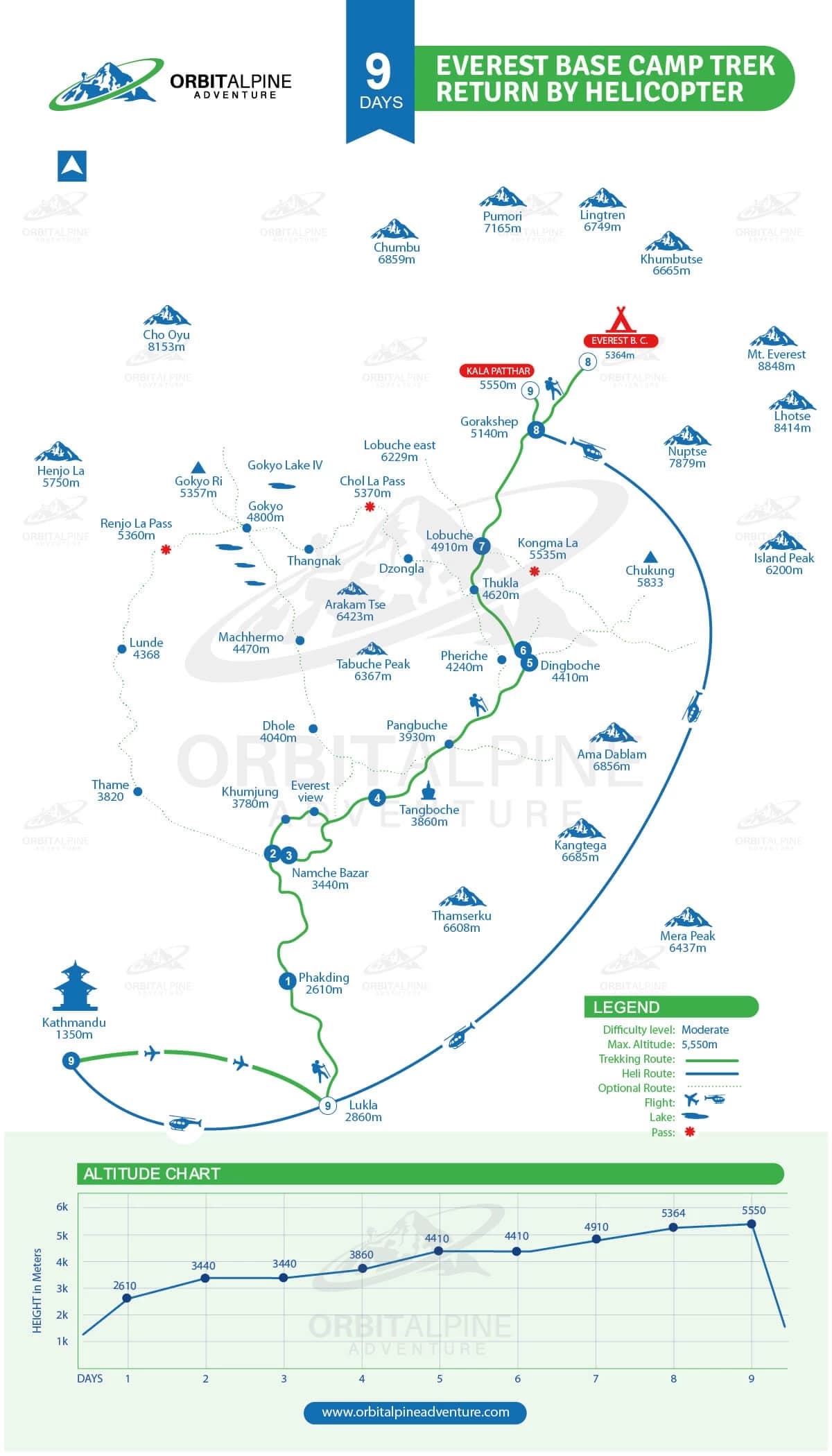
- Normally Everest base camp trek is moderate type of trek so it is better to do an everyday morning walk or hike locally before coming to do this trek in Nepal
- If you are taking regular types of medicine please consult to your doctor that you are going to do a Everest base camp trek with a return helicopter in Nepal. And also please make sure that you have enough medicine for your Everest base camp trek.
- Once you start the Everest base camp trek with a return back helicopter and due to any personal reason and natural calamities if you are not able to continue it your amount will not be refunded.
- It is better to consult about all types of equipment, materials you need as well as the rules and regulations for Everest trek and return helicopter with your organizing company.
The highest point to reach during the Everest Base Camp trek is Kala Patthar, which is at the an elevation of 5,550m. You hike to Kala Patthar from Gorak Shep early in the morning to have the sunrise view of Everest.
Yes, you can also do EBC trek solo as there is no region restricted for international tourists. If you can manage to obtain the required permits such as TIMS card and Sagarmatha National Park Entry Permit, you can do it. However, we recommend either an organized trekking tour or consulting with a trekking agency in Kathmandu. It may not be easy for you to book the hotels during the trek or navigate the right trail. If you hire a professional guide, they will manage everything for your successful trip to Everest.
Although there are frequent flight services to Lukla from Kathmandu, flights to other parts are available only if chartered solo or in a group. However, if you book the Everest region trekking package with a helicopter return flight, Orbit Alpine Adventure manages it for you. If you trek down to Lukla by following the same trail to EBC, the cost is low. In case you want to experience a Chopper return to Kathmandu, the cost is comparatively high. For more detail, you can contact Orbit Alpine Adventure either via email, phone calls, WhatsApp or online reservation services.
Truly speaking, you can do the Everest Base Camp trek at all times of the year depending on your choice and vacation schedule. If you want to walk through a less crowded trail, the EBC trek in winter is the best option. If you can prefer verdant landscapes covered with colorful rhododendron flowers, you can trek to EBC in summer. Spring and autumn seasons are the best for the Everest Base Camp trek to have the clear vistas of the snowcapped peaks. Since the days are warm and mornings and nights cold, spring is the most favourable time for experiencing the highest peak region in the world.
Kala Patthar, the highest point at 5,550m is the vantage point of EBC trek. To have a 360-degree panoramic view of Mt. Everest, Mt. Lhotse, Mt. Cho Oyu and Mt. Pumori, it is the best place. You must reach to this vantage point from Gorak Shep as soon as possible in the morning to have the sunrise view of the entire Everest region. Mt. Everest is not clearly seen from the base camp as Mt. Lhotse blocks it from sight. Therefore, you must reach Kala Patthar to have the complete panorama of the eight-thousanders and other snowy peaks.
For sure, you can also fly from Kala Patthar to Kathamndu, as a helicopter can land on there as well. During Everest Base Camp helicopter tour, the helicopter flies to Kala Patthar from Lukla or Everest View Hotel. A flight over Everest lets you have more interesting sight of the Khumbu region than trekking through the trails. To get more knowledge about flight to Kathmandu from Kala Patthar, contact Orbit Alpine Adventure.
There are a lot of benefits of flying Kathmandu from Everest region rather than walking down the same trail. First of all, you can have a complete aerial view of the Everest region which is not possible by walking. Next, you arrive Kathmandu within very short time, saving your four days that you can use to visit other tourist destinations.
This service allows you to experience the world’s highest peak even if you have short period of time to spend in Nepal. The in-flight view of the glaciers, icefalls, amazing snowy peaks, Sherpa settlement areas and ancient monasteries is superb lifelong experience!
At the time of booking, our team will help you carefully with the preparations and packing all the necessary gears.
- Comfortable underwear
- Insulated down jacket
- Windproof upper body layer and trouser
- Hiking boots
- Hat, gloves, and scarf
- Sunglasses that protects from UV-A & UV-B
- Day pack
- Reusable water bottle
- Small toiletry bag (sunscreen, lip balm, tissue paper, band-aids, etc.)
- Camera & spare batteries (optional)
- Some amount of money if you want to have tea, coffe at the helicopter refulling point and view point.
